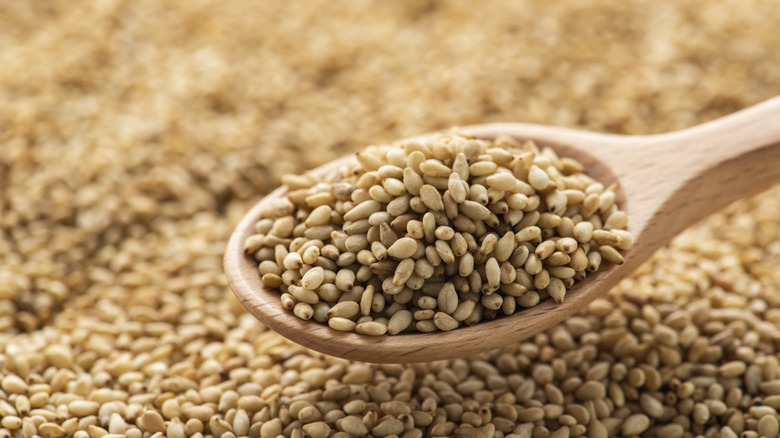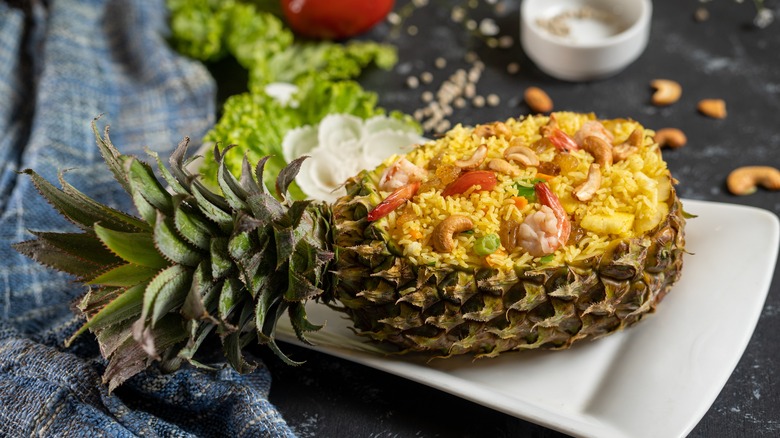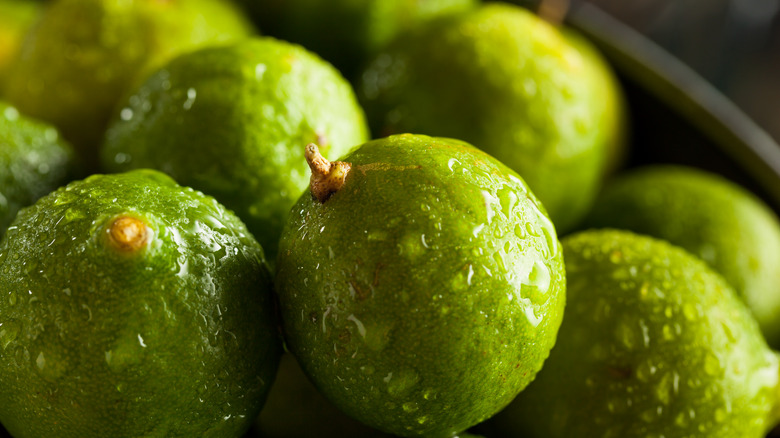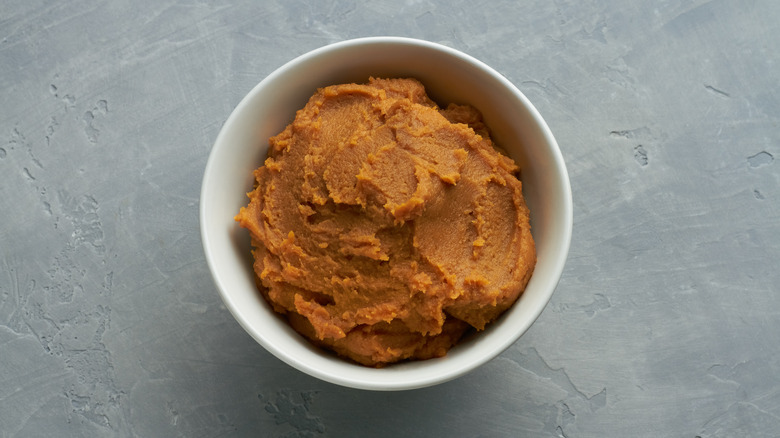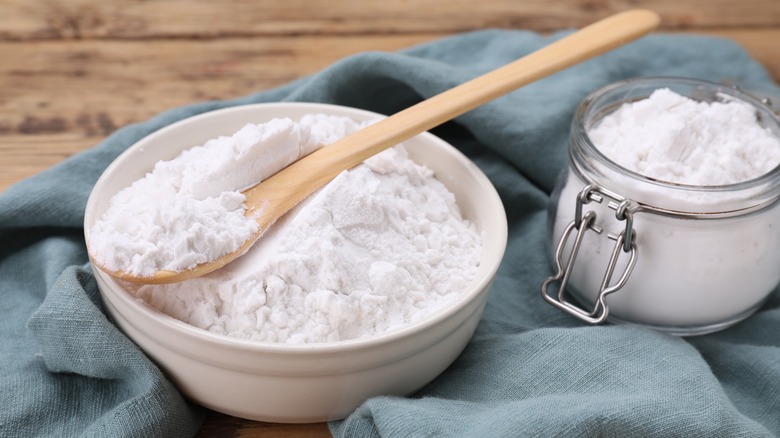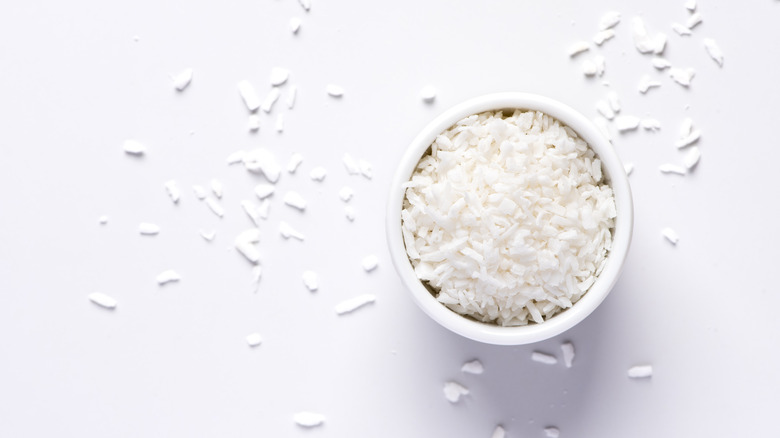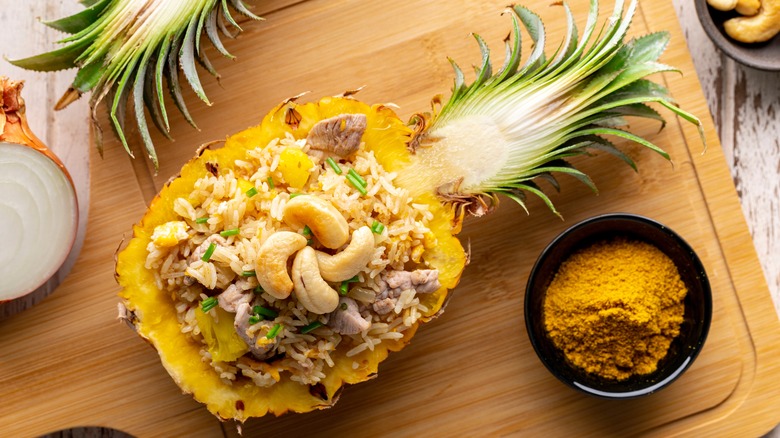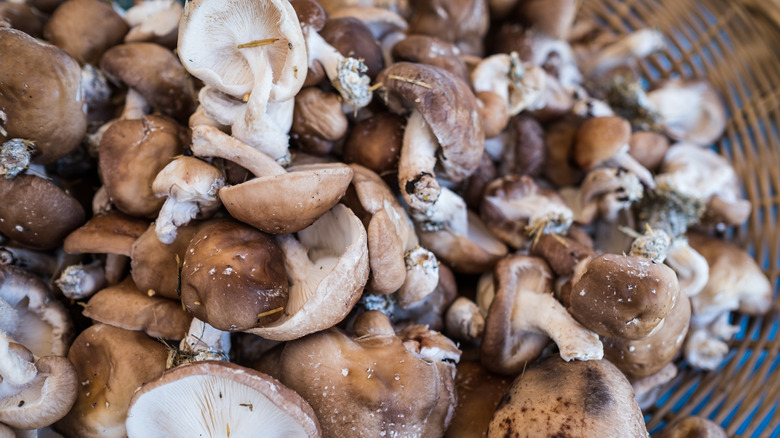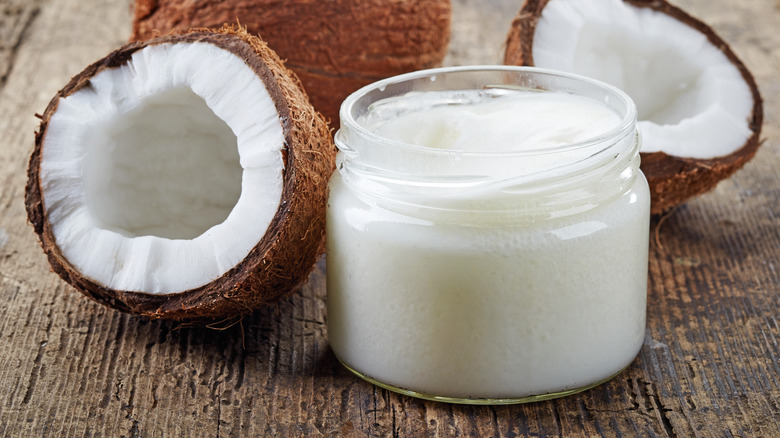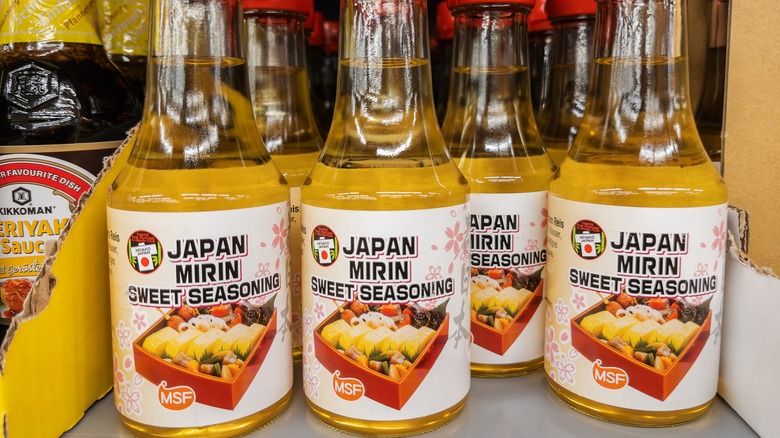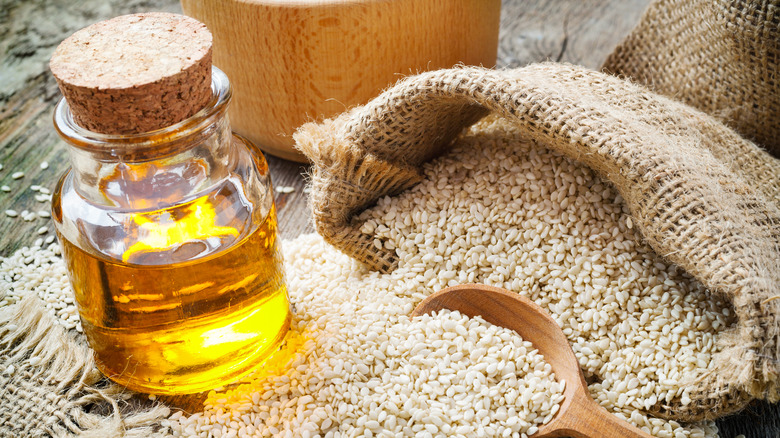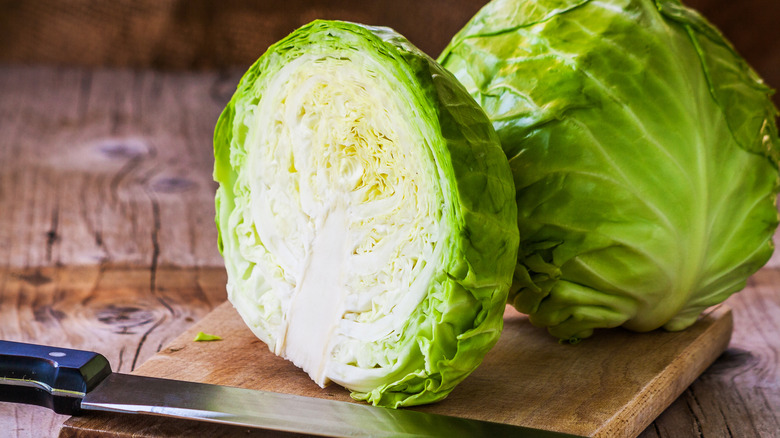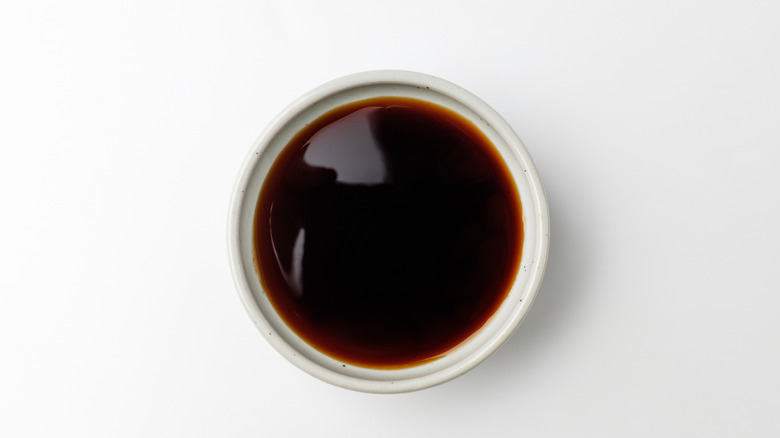15 Unique Ingredients You Should Add To Fried Rice
There's just something special about getting your Asian cuisine boxed up at a restaurant and enjoying it in front of the television at home. Takeout is a vibe, and Chinese food has a certain flavor that may be hard to replicate unless you have a background in Asian cooking. As a chef and recipe designer, I consider a few things when I make my own version of a dish or alter a classic recipe. The first is flavor, and the second is texture. Both elements should blend in flawlessly or enhance the dining experience. Thinking outside of the box can be risky, but if you follow a few parameters there are endless unique ingredients you could add to your fried rice.
It's time to raid the back of your refrigerator and get cooking. There are plenty of ingredients beyond onions, corn, broccoli, carrots, shoos, eggs, and peas that can make fried rice sing. In fact, they can even create a whole new flavor profile you never knew existed. It's important not to go hog wild and just throw any old ingredients in the pan, but there is an array of unique ingredients that just seem to work.
Sesame seeds
When it comes to homemade fried rice, texture is often overlooked. Freshly cooked rice doesn't always do the trick. Instead, use leftover rice that is slightly dried out to get that nice fried crispy crunch. Another way to enhance the crispiness is by adding sesame seeds. The flavor of sesame is essential for quality fried rice and is sometimes added in the form of sesame oil. However, the addition of sesame seeds can create not only a depth of flavor but also change the texture.
If you're wondering what sesame seeds even are, they come from the fruit of the sesamum indicum plant and are used to make a range of products. Have you ever had tahini? Tahini comes from ground sesame seeds and has a texture similar to peanut butter. The seeds are pressed to make sesame oil. However, left unaltered, they can be used in dishes like sushi, salads, and even fried rice. Use a tablespoon or 2 of sesame seeds, and add them when you add your rice to prevent them from getting overcooked or burned. They have a toasty flavor and a pleasing crunch.
Canned pineapple
Your average fried rice tends to be vegetable-heavy, with the addition of meat, seafood, or tofu. Caramelized onions and chopped carrots can bring all the sweetness the dish needs, but there are other ways to deliver that sweet and savory combination. Fruit should not be overlooked just because a dish is hot or cooked, and it can often help to balance the flavor of meats. Try adding pineapple to your fried rice. It pairs with seafood, white and red meats, and plant-based proteins well because of its light, citrus-like flavor and slight acidity.
Pineapple is incredibly sweet and holds up well when cooked, especially over high heat. Make your life easier by including canned pineapple in your fried rice. This can help to bring the flavor, without the mess. A smaller cut pineapple chunk does well so that a mouthful of pineapple doesn't overwhelm the rest of the dish. On that note, use less pineapple than you think you might need. It's easy for the dish to become too sweet quickly, and you can always add more in.
Lime zest
Fried rice can easily become an everything-but-the-kitchen-dish kind of meal, which is one of the reasons we love it. However, flavoring the rice is just as important as the vegetables and meats you decide to include. Rice itself is fairly bland and becomes a vehicle for sauces and spices. This is what makes the dish so powerful. Typically, an acid like rice vinegar is added to give it a punch of flavor, but another way to add some depth via acidity is to include citrus. A small squirt of lime should do the trick, but for next-level flavor include some of the rind, as well.
To do this simply use lime zest. It pays to zest your citrus upside down because it can give you more control surrounding how much goes into your dish, and can prevent you from adding too much pith. Who knew zesting was such an art? Lime zest can add a slight sweetness, bitterness, and acidity that is quite aromatic. Don't get too overzealous, and keep your added zest to a light sprinkle after removing the rice from the heat.
Miso
There are plenty of ways to make fried rice sauce. If you're a fried rice master then you may add your sauce and spices one by one in your pan or on your Blackstone. However, the rest of us mere mortals may need to measure and mix in a separate bowl to create a dynamic balance. If this is you, then consider taking advantage of the situation and incorporating miso. Miso comes in a paste-like form that can be difficult to add right to the pan of rice but will distribute evenly when whisked into a sauce. If you've never heard of or used it in your cooking, beyond the ever-popular miso soup, then your culinary life is about to change.
The most important thing that you need to know about miso, is that it has a buttery umami flavor. Umami is the rich and savory flavor that can be found in meat, tomato paste, and shiitake mushrooms, to name a few. It creates a lingering and savory mouthfeel that's quite pleasing and is often used in Asian cuisine. Whisk a spoonful into your sauce, and let it speak for itself. Miso makes for an incredible secret ingredient to elevate your fried rice.
Cornstarch
Master cooks are always looking for unique ways to increase the quality of the texture of their dishes. Whether a dish is creamy, crunchy, chewy, or crispy has entirely to do with both the ingredients and how they are prepared. Nobody enjoys mushy or clumpy fried rice, and there are several ways to ensure that doesn't happen. The first is to use rice that has sat in the refrigerator and dried out slightly, instead of freshly made rice. You'll also want to crank that heat so the rice doesn't have a chance to get overcooked or softened. Lastly, you could toss your rice in a little cornstarch before adding it to the hot pan.
A dash of cornstarch can improve fried rice by helping to keep those grains separated, and by absorbing any extra moisture. In this case, dry rice is your best friend, and cornstarch can help to ensure that. Just add a small amount, and wait until the oil is hot to add your rice to the pan.
Spam
Spam is one of those foods that you either love or can't stomach the idea of. When cooked correctly, Spam can be an inexpensive and delicious addition to many meals. There are many ways to use canned Spam, which makes it a versatile meat to cook with. It may not be the fancy fillet mignon or fresh lamp chop that you get from the local butcher, but it does the trick in the flavor department. One of the absolute best ways to use leftover Spam is by adding it to your fried rice.
Dice it up into small pieces, and pan-fry it until it starts to become crispy. It is best when cooked on its own so that the water from the vegetables doesn't prevent it from crisping. Spam doesn't need any seasoning and certainly doesn't need any additional salt. Mix it back in right at the end to warm it up, and serve your fried rice hot. Spam doesn't always play nice with other meats, so allow it to be the primary protein of the dish.
Shredded coconut
There are a few different angles you can take when it comes to picking a theme for your fried rice. You could go the farmers market route and include broccolini, fennel, and turnips. You could stick to the authentic recipe and rely on the classic aromatics. Or, you could go tropical and use seafood, pineapple, and coconut. While shrimp and pineapple don't seem like too much of a stretch, coconut fried rice may be something you've never experienced before. If the idea tickles your tastebuds then consider sprinkling in some unsweetened shredded and dried coconut.
These shredded coconut flakes work similarly to a panko crust as they deliver a chewy, crunchy, and crispy texture when toasted. Mix the coconut right into your rice and fry it along with the grain. It will have a subtle sweet and fruity flavor and pairs particularly well with shrimp, spam, and tofu. It's the unexpected unique ingredient that can add texture, flavor, and intrigue to your next homemade fried rice endeavor.
Cashews
Did you know that cashews are a fruit and come from a bush? While you come down from that revelation, we will hit you with another one. Cashews are incredible in stir fry. They become brown, toasty, and soft and can add density, diversity of texture, and a buttery flavor. Pan-frying and roasting cashews will give you the best flavor, so it's no wonder they shine in fried rice.
Once the veggies are cooked, add the cashews. They will become soft, and may even split in half when cooked. Avoid burning them, but allow them to brown as the rice crisps up. If you desire a plant-based fried rice, tofu is not your only option (although it's a darn good one). Don't worry about overcrowding your fried rice with cashews, because their flavor is so subtle that it won't overwhelm your other vegetables. They will also absorb some of the sauce and become a vehicle for flavor alongside the rice.
Shittake mushrooms
Peas make such a classic addition to fried rice because they carry their own texture that tends to complement the rice. They hold up well in a pan and bring a subtle sweetness to the mix. Mushrooms are just as valuable, but serve a different purpose. They carry a chewy texture and a strong umami flavor that tends to contrast with the other vegetables. However, the umami of the soy sauce reflects the umami of shiitake mushrooms and the two make a devilishly delicious pair.
Consider using sliced shiitake mushrooms in your fried rice. Slice the mushrooms so that they are in long strips, and don't forget to chop up that stem, as well. Your mushrooms may take longer to cook than some of the other vegetables, and do well in a dry pan with a little bit of oil. Avoid stirring them in order to allow them to crisp and brown on at least one side. They make a fantastic addition to vegetarian fried rice, but can also be paired with both meats from land and sea, especially those with gamey undertones.
Coconut oil
Canola oil is great for cooking at high temperatures because of its high smoke point. It has a neutral flavor, so often a little sesame oil is added to fried rice to give it flavor and density. There is, however, another oil that should be considered. Coconut oil has a soft and fatty mouthfeel similar to butter and can be used in addition to, or in place of, canola oil.
If you're new to the world of coconut oil, do a little research or follow a guide to cooking with coconut oil. It's solid at room temperature but will melt down immediately when exposed to heat. Choose unrefined coconut oil for a fruity flavor if cooking with seafood, or use refined for a more neutral flavor. Refined coconut oil has a smoke point of 400 F, so it can be used at a higher heat, which makes it a great candidate for fried rice. Coconut oil fried rice has a richer mouthfeel and is more decadent. Because it's mostly saturated, try not to go overboard and instead add it in moderation.
Sugar
For the perfect balance of flavor, fried rice should contain elements of salt, acid, fat, and sugar. The soy sauce, oil, and rice vinegar do the trick for the first three, but often the sweet aspect goes overlooked. There are a few options that you can choose when it comes to adding sweeteners to your fried rice. The secret ingredient for better-fried rice is the most simple: sugar.
Don't overthink it. A simple dash of sugar can make all the difference. If you're looking for a different approach, mirin is the ingredient your fried rice may be missing. Mirin covers both the sweet and the savory and even has a slight acidity as it is a fermented rice wine. Think of it like sweet, tangy sake that will deliver more than just sugary notes. Even a dash of maple syrup can work in a pinch and don't feel the need to shy away from brown sugar if that's what you have in your pantry. The goal is to add enough to balance the flavor without creating an overly sweet or dessert-like dish.
Sesame oil
While your primary oil should remain something rather neutral like canola, vegetable, or refined coconut oil, consider including some sesame oil for flavoring. Sesame oil has a nutty, toasty flavor and a very dense and fatty mouthfeel. Just a little bit goes a long way, so use it to season your rice to create that wonderful rich, and fatty taste we love so much.
Sesame oil is one of the best types of oil for an extra nutty flavor. It's slightly sweet and earthy and has a strong aroma. It has a slightly darker coloring than most oils and is made from pressed-toasted sesame seeds. Add an extra boost of sesame by mixing in some sesame seeds to your rice, or using them as a garnish. A few splashes on the hot rice should do the trick, and even though it's just a little bit it will make all the difference.
Cabbage
Shredded cabbage can enhance almost any savory Chinese dish. When chopped into thin strips, it almost acts like noodles to capture sauces and flavor and carry them into your mouth. It can also help to add a little moisture and bring the textures of the vegetables and crispy rice together. Use green cabbage, or napa cabbage for best results. Red cabbage tends to have a rougher texture and spicier flavor, but can certainly be used if that's your preference.
Grab a freshly sharpened knife and shave thin strips of cabbage onto your cutting board. Like most vegetables, cabbage is water-dense and needs to be cooked prior to adding rice to the hot pan. Your goal is to get the cabbage to a point where it's fully limp and begins to dry out once the moisture is released. You can add quite a bit of it, just be sure it doesn't dominate your vegetable-to-rice ratio.
Japanese barbecue sauce
If you're looking for a darker, richer, sweeter, and more intense flavor for your homemade fried rice, consider including some Japanese barbecue sauce. While you can rely entirely on this sauce for flavoring, it's recommended that you still add your traditional oils, seasonings, and ingredients, and then replace about half of the soy sauce with Japanese barbecue sauce. It's a surefire way to ensure hypnotic flavors with the simple squirt of a bottle.
There are plenty of different premade Japanese barbecue sauce brands out there with a range of flavors. A classic like Bachan's Hella Hot Japanese barbecue sauce is best for those with a taste for heat, but you can also find miso and yuzu-based sauces. This decision should be based entirely on personal preference, and if you're feeling unsure remember that just a tablespoon of sauce can go a long way. Start with just a little, or let folks add it to their fried rice after it's been plated.
Sriracha
If you can get your hands on a bottle of the good stuff, consider adding a little sriracha to your fried rice. Some like it hot, and if that's you then just a dash of this famous sauce can make a world of difference. If you're unable to get your hands on a bottle of the original, use an alternative brand or make your own homemade sriracha. Of course, they won't taste just like the original, but if used as an ingredient amongst others it can get the job done.
Alternatively, try using red pepper flakes but understand that they blossom with heat and time. If you're feeding a crowd, it may be a good idea to let individuals add sriracha to their dish after it's been plated so that they can control how much heat is actually going into it. It's difficult for us spice lovers to comprehend, but not everyone loves to be steaming out of the ears with each bite.

